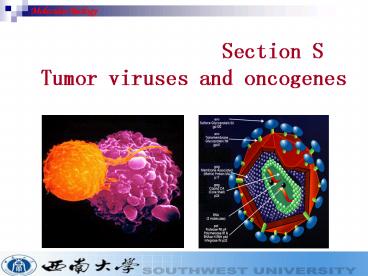Section S Tumor viruses and oncogenes - PowerPoint PPT Presentation
1 / 12
Title:
Section S Tumor viruses and oncogenes
Description:
Cancer Cancer results from mutations that disrupt the controls regulating normal cell growth. ... c) A schematic diagram of the stages of apoptosis. Molecular Biology ... – PowerPoint PPT presentation
Number of Views:97
Avg rating:3.0/5.0
Title: Section S Tumor viruses and oncogenes
1
Section STumor viruses and
oncogenes
Molecular Biology
2
S1 ONCOGENES FOUND IN TUMOR VIRUSES
Molecular Biology
Cancer Cancer results from mutations that
disrupt the controls regulating normal cell
growth. Oncogenes Oncogenes are genes whose
overactivity causes cells to become cancerous.
Oncogenic retroviruses Oncogenic retroviruses
were the source of the first oncogenes to be
isolated. Isolation of oncogenes The isolation
of oncogenes was aided by the development of an
assay which tests the ability of DNA to transform
the growth pattern of NIH-3T3 mouse fibroblasts.
3
S1 ONCOGENES FOUND IN TUMOR VIRUSES
Molecular Biology
Fig. 1. Testing for the presence of an oncogene
in DNA by revealing its ability to cause a change
in the growth pattern of NIH-3T3 cells.
4
S1 ONCOGENES FOUND IN TUMOR VIRUSES
Molecular Biology
Fig. 2. The mechanism by which MMTV causes cancer
in mouse mammary cells. (a) The mouse int-2 gene
before integration of the MMTV provirus (b)
integration of the provirus results in
overexpression of int-2.
5
S2 CATEGORIES OF ONCOGENS
Molecular Biology
Oncogenes and growth factors Many oncogenes code
for proteins that take part in various steps in
the mechanism by which cells respond to growth
factors. Nuclear oncogenes Other oncogenes code
for nuclear DNA-binding proteins that act as
transcription factors regulating the expression
of other genes involved in cell division.
Cooperation between oncogenes When normal rat
fibroblasts taken straight from the animal are
transfected with oncogenes, it is found that both
a growth factor-related and a nuclear oncogene
are required to convert the cells to full
malignancy.
6
S2 CATEGORIES OF ONCOGENS
Molecular Biology
Fig. 1. The fms oncogene codes for a growth
factor receptor that is mutated so that it is
constitutively active.
7
S3 TUMOR SUPPRESSOR GENES
Molecular Biology
Overview Tumor suppressor genes cause to become
cancerous when they are mutated to become
inactive. Evidence for tumor suppressor genes
Evidence includes the behavior of hybrid cells
formed by fusing normal and cancerous cells,
patterns of inheritance of certain familial
cancers and loss of heterozygosity for
chromosome markers in tumor cells. RB1 gene The
RB1 gene was the first tumor suppressor gene to
be isolated. p53 gene p53 is the tumor
suppressor gene that is mutated in the largest
number of different types of tumor.
8
S3 TUMOR SUPPRESSOR GENES
Molecular Biology
Fig. 1. Loss of heterozygosity is the process
whereby a cell loses a portion of a chromosome
that contains the only active allele of a tumor
suppressor gene.
9
S3 TUMOR SUPPRESSOR GENES
Molecular Biology
Fig. 2. Retinoblastoma results from the
inactivation of both copies of the RB1 gene on
chromosome 13. This can occur by mutation of both
normal copies of the gene (sporadic
retinoblastoma) or by inheritance of one inactive
copy followed by an acquired mutation in the
remaining functional copy (familial
retinoblastoma).
10
S3 TUMOR SUPPRESSOR GENES
Molecular Biology
Fig. 3. The dominantnegative effect of a mutated
p53 gene results from the ability of the protein
to dimerize with and inactivate the normal
protein.
11
S4 APOPTOSIS
Molecular Biology
Apoptosis Apoptosis is an important pathway that
results in cell death in multi-cellular
organisms. Removal of damaged or dangerous cells
Apoptosis has an important role in removing
damaged or dangerous cells, for example in
prevention of autoimmunity or in response to DNA
damage. Cellular changes during apoptosis In
apoptosis, the chromatin in the cell nucleus
condenses and the DNA becomes fragmented. Apoptosi
s in C. elegans The ced-3 and ced-4 genes are
required for cell death, which can be suppressed
by the product of the ced-9 gene, the absence of
which results in excessive apoptosis. Apoptosis
in mammals The mammals homolog of C.elegans
ced-9 is bcl-2, which acts to suppress apoptosis.
Apoptosis in disease and cancer Defects in
apoptosis are important in disease and cancer.
Some proto-oncogenes such as bcl-2 prevent
apoptosis, reflecting the role of
apoptosis-suppression in tumor formation.
12
S4 APOPTOSIS
Molecular Biology
Fig. 1. Apoptosis. a) A characteristic DNA ladder
from cells undergoing apoptosis. b) A microscopic
image of T-cells showing apoptotic bodies
(apoptotic cell marked with an arrow, original
picture from Dr D. Spiller). c) A schematic
diagram of the stages of apoptosis.































